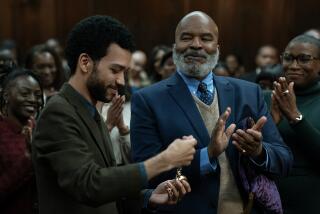Book review: ‘The Last Greatest Magician in the World’ by Jim Steinmeyer
The Last Greatest Magician in the World
Howard Thurston Versus Houdini & the Battles of the American Wizards
Jim Steinmeyer
Tarcher/Penguin: 377 pp., $26.95
It takes some courage to write the biography of a man the reading public has mostly forgotten. Yet that’s exactly what Jim Steinmeyer does in “The Last Greatest Magician in the World,” a biography of the now-obscure Howard Thurston, the illusionist who held the title by acclaim in the 1920s and ‘30s. It’s a clever marketing trick, and a necessary one, to include Houdini’s name in the lumbering subtitle, but it’s a piece of misdirection that, like many events in this telling of Thurston’s life, doesn’t play out quite the way it’s supposed to.
That’s a shame because Thurston’s life is fascinating. Steinmeyer details his Horatio Alger-like ascent from youthful pickpocket and con artist to the best-known magician of his era. It’s a journey Thurston often takes in tandem with one of his three brothers, Harry, a Chicago con artist who runs risqué “hootchie-cootchie” shows and becomes Thurston’s sometime financier.
In a chapter-closing sentence, Steinmeyer notes that this brotherly arrangement “was a decision [Thurston would] regret for the rest of his life” — but this narrative gamble never pays off as the two men work in apparent harmony. Other potential conflicts also dissolve. Four wives more or less disappear — in both senses of the word — and so does Thurston’s brother Charles, murdered while he worked as a detective for the Pennsylvania railroad.
Yet the story wends its way pleasantly enough through Asian and European tours before it comes home to the States. Here Thurston teams up with Harry Kellar — then the most famous magician in the world, a title Thurston would inherit when Kellar retired in 1908. A certain sameness sets in at this point, exacerbated by the way Steinmeyer organizes many chapters around the slow development and perfection of an illusion. This distracts the reader from Thurston’s fascinating psychology and the way it shapes his relationship with the fractious community of professional magicians around the turn of the 20th century.
It also sets up a contract it refuses to keep. In describing each new illusion, Steinmeyer devotes paragraphs to the apparatus that makes the trick possible — without ever quite describing it, showing how it works or explaining how it is hidden from the audience. Given Steinmeyer’s professional résumé as a magic designer for artists including Doug Henning and David Copperfield, his instinct for reticence is understandable. But it conflicts with his impulse to also position himself as an insider with specialized knowledge to dispense.
By the time the book reaches Thurston’s death in 1936, another narrative gambit has faltered. Despite equal billing in the subtitle, Houdini has engineered yet another great escape — this one from the book itself. He hovers on the margins and occasionally makes a cameo (at a dinner for magicians, at the Chicago World’s Fair) but never does he sustain an appearance long enough to create any real conflict, much less a battle of American wizards.
Bailey is the author of the novels “House of Bones” and “The Fallen,” and a collection of short stories, “The Resurrection Man’s Legacy and Other Stories.”
More to Read
The biggest entertainment stories
Get our big stories about Hollywood, film, television, music, arts, culture and more right in your inbox as soon as they publish.
You may occasionally receive promotional content from the Los Angeles Times.






